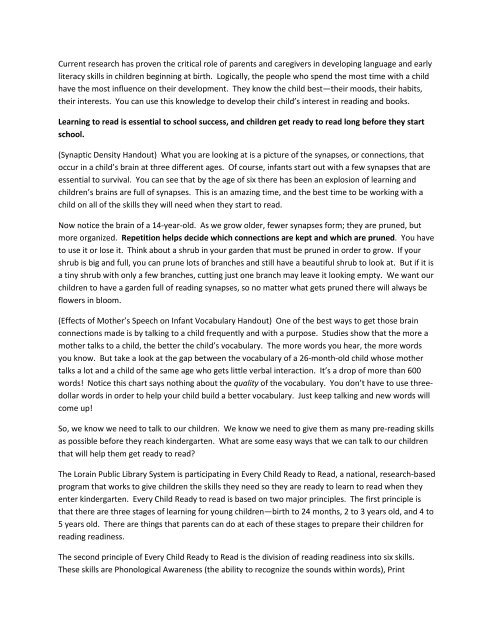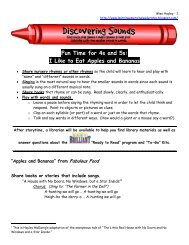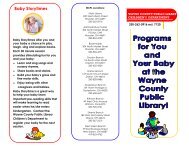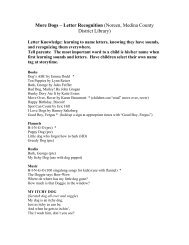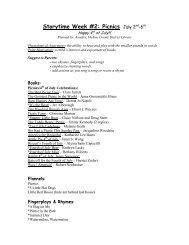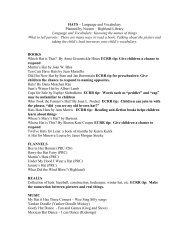presentation script - Ohio Ready to Read
presentation script - Ohio Ready to Read
presentation script - Ohio Ready to Read
Create successful ePaper yourself
Turn your PDF publications into a flip-book with our unique Google optimized e-Paper software.
Current research has proven the critical role of parents and caregivers in developing language and early<br />
literacy skills in children beginning at birth. Logically, the people who spend the most time with a child<br />
have the most influence on their development. They know the child best—their moods, their habits,<br />
their interests. You can use this knowledge <strong>to</strong> develop their child’s interest in reading and books.<br />
Learning <strong>to</strong> read is essential <strong>to</strong> school success, and children get ready <strong>to</strong> read long before they start<br />
school.<br />
(Synaptic Density Handout) What you are looking at is a picture of the synapses, or connections, that<br />
occur in a child’s brain at three different ages. Of course, infants start out with a few synapses that are<br />
essential <strong>to</strong> survival. You can see that by the age of six there has been an explosion of learning and<br />
children’s brains are full of synapses. This is an amazing time, and the best time <strong>to</strong> be working with a<br />
child on all of the skills they will need when they start <strong>to</strong> read.<br />
Now notice the brain of a 14-year-old. As we grow older, fewer synapses form; they are pruned, but<br />
more organized. Repetition helps decide which connections are kept and which are pruned. You have<br />
<strong>to</strong> use it or lose it. Think about a shrub in your garden that must be pruned in order <strong>to</strong> grow. If your<br />
shrub is big and full, you can prune lots of branches and still have a beautiful shrub <strong>to</strong> look at. But if it is<br />
a tiny shrub with only a few branches, cutting just one branch may leave it looking empty. We want our<br />
children <strong>to</strong> have a garden full of reading synapses, so no matter what gets pruned there will always be<br />
flowers in bloom.<br />
(Effects of Mother’s Speech on Infant Vocabulary Handout) One of the best ways <strong>to</strong> get those brain<br />
connections made is by talking <strong>to</strong> a child frequently and with a purpose. Studies show that the more a<br />
mother talks <strong>to</strong> a child, the better the child’s vocabulary. The more words you hear, the more words<br />
you know. But take a look at the gap between the vocabulary of a 26-month-old child whose mother<br />
talks a lot and a child of the same age who gets little verbal interaction. It’s a drop of more than 600<br />
words! Notice this chart says nothing about the quality of the vocabulary. You don’t have <strong>to</strong> use threedollar<br />
words in order <strong>to</strong> help your child build a better vocabulary. Just keep talking and new words will<br />
come up!<br />
So, we know we need <strong>to</strong> talk <strong>to</strong> our children. We know we need <strong>to</strong> give them as many pre-reading skills<br />
as possible before they reach kindergarten. What are some easy ways that we can talk <strong>to</strong> our children<br />
that will help them get ready <strong>to</strong> read?<br />
The Lorain Public Library System is participating in Every Child <strong><strong>Read</strong>y</strong> <strong>to</strong> <strong>Read</strong>, a national, research-based<br />
program that works <strong>to</strong> give children the skills they need so they are ready <strong>to</strong> learn <strong>to</strong> read when they<br />
enter kindergarten. Every Child <strong><strong>Read</strong>y</strong> <strong>to</strong> read is based on two major principles. The first principle is<br />
that there are three stages of learning for young children—birth <strong>to</strong> 24 months, 2 <strong>to</strong> 3 years old, and 4 <strong>to</strong><br />
5 years old. There are things that parents can do at each of these stages <strong>to</strong> prepare their children for<br />
reading readiness.<br />
The second principle of Every Child <strong><strong>Read</strong>y</strong> <strong>to</strong> <strong>Read</strong> is the division of reading readiness in<strong>to</strong> six skills.<br />
These skills are Phonological Awareness (the ability <strong>to</strong> recognize the sounds within words), Print
Awareness (understanding that print is everywhere, that letters and words have meaning, and learning<br />
how books work), Print Motivation (the interest in books and reading), Vocabulary (learning new words),<br />
Narrative Skills (understanding the parts of a s<strong>to</strong>ry), and Letter Knowledge (knowing the ABC’s). This<br />
may sound like a lot of skills for a six-year-old <strong>to</strong> learn, but these are things that can be easily taught<br />
through play, and children at this age are eager <strong>to</strong> learn anything you want <strong>to</strong> teach them!<br />
Some of the resources we have at the library include handouts with suggested activities, computer<br />
games that cover all six skills, and <strong>to</strong>ys that reinforce reading readiness. We even have backpacks filled<br />
with <strong>to</strong>ys, games, books, and CD’s that are tailored <strong>to</strong> fit each skill. (Show example backpack and explain<br />
how the items inside fit with the particular skill.)<br />
Recently, the State Library of <strong>Ohio</strong> has provided libraries with copies of the book You, Me, and the ABC’s<br />
by Michael J. Rosen. This book is full of activities that a parent can do with their child <strong>to</strong> jumpstart their<br />
reading career.<br />
There are two things <strong>to</strong> keep in mind while using this book with your child. First, learning literacy skills<br />
should be FUN. Never force your child <strong>to</strong> work on a certain skill as though they are in school. This is not<br />
lesson time, it is play time. Kids should view word and letter activities like any other game or <strong>to</strong>y.<br />
Making learning time and play time makes sure your child will want <strong>to</strong> learn and will learn more.<br />
Secondly, the activities in this book are just a starting point. In order for early literacy play <strong>to</strong> work, it<br />
must become part of your everyday routine. Think about your day and how busy you are. If you try <strong>to</strong><br />
fit half an hour of “lessons” in that cover letters and words, you will soon become frustrated and<br />
discouraged. Instead, incorporate letters and literacy in<strong>to</strong> the things you already do. Chances are, you<br />
are already doing many things that help prepare your child for reading. You, Me, and the ABC’s will just<br />
give you some new ideas <strong>to</strong> incorporate literacy in<strong>to</strong> your life.<br />
So, let’s start with the beginning <strong>to</strong> our day—breakfast. Turn <strong>to</strong> pages 10 and 11 in your copy of You,<br />
Me, and the ABC’s. How easy is it <strong>to</strong> go <strong>to</strong> the s<strong>to</strong>re and buy some generic alphabet cereal? As soon as a<br />
<strong>to</strong>ddler can pick up a piece of cereal, he or she can be learning the letters in his or her name! Even if<br />
they can’t answer back, you can still point out their first initial in their cereal, on street signs, in the<br />
newspaper, even on your cell phone! Usually, the first letters children learn are those in their name,<br />
and it is also usually the first word they learn <strong>to</strong> recognize on paper. Notice that every page in the book<br />
has both a capital and lowercase letter. It is important for children <strong>to</strong> learn both sets of letters for<br />
reading readiness. All of this, of course, leads <strong>to</strong> our skill Letter Knowledge. And, for a bonus, if you talk<br />
about the sounds a letter makes that’s Phonological Awareness.<br />
Let’s talk about Phonological Awareness for a second. This tends <strong>to</strong> be the hardest skill for a lot of<br />
children. This is one skill that can start from birth and really evolve through a preschooler’s<br />
development. The best thing you can do with a child <strong>to</strong> increase Phonological Awareness is <strong>to</strong> sing. The<br />
notes of a song naturally break up words in<strong>to</strong> syllables that are easily distinguished. Think about<br />
“Twinkle, Twinkle, Little Star.” (Sing song even if you have no singing voice and clap on each beat <strong>to</strong><br />
show how each syllable has its own note.) Don’t worry if you can’t sing. I’m willing <strong>to</strong> bet that many of<br />
you want <strong>to</strong> cover your ears when your preschooler sings in the car, right? Totally <strong>to</strong>ne deaf! But sing
<strong>to</strong> a child, especially babies, because they love <strong>to</strong> hear your voice and because they will learn <strong>to</strong> hear the<br />
different sounds of words. For the littlest child, there are also animal noises. Saying “moo” is actually a<br />
great way for a child <strong>to</strong> think about the sound their mouth is making.<br />
For two and three year olds, try the game on pages 14 and 15. Pick a day and listen for the sound of a<br />
certain letter. Easy sounds <strong>to</strong> start off with are the sounds of letters t, b, d, and p. These are easy <strong>to</strong><br />
hear because they have that hard, aspirated sound whether at the beginning, middle, or end of a word.<br />
However, you are going <strong>to</strong> want <strong>to</strong> start with beginning sounds since those are even easier <strong>to</strong> hear.<br />
Once the child has mastered the art of a beginning sound, move on <strong>to</strong> rhyme. This is one of the hardest<br />
and most complex skills <strong>to</strong> master, so the earlier a child gets started, the better. Again, singing will help.<br />
Start a song and have your preschooler finish a verse with the correct rhyming word. (Sing example<br />
song of your choice.)<br />
One of the hardest skills <strong>to</strong> “teach” is Narrative Skills, or the ability <strong>to</strong> understand how a s<strong>to</strong>ry flows.<br />
Children need <strong>to</strong> know that s<strong>to</strong>ries have a beginning, a middle, and an end and that there are characters<br />
in a s<strong>to</strong>ry. One of the best ways <strong>to</strong> encourage a child <strong>to</strong> think about how s<strong>to</strong>ries work is <strong>to</strong> have them<br />
tell the s<strong>to</strong>ry of their day. On page 16, the activity directs you <strong>to</strong> create a “To Do” list that you can cross<br />
off during the day as you complete activities. Then, as a bedtime s<strong>to</strong>ry, talk about the things you did<br />
during the day. This activity does double-duty because it also enhances Print Awareness. By writing<br />
things down, it shows the importance of words and writing. For younger children, you can use pictures<br />
of certain activities or even just show them the grocery list and let them help shop for the day!<br />
Page 52 has tips for Print Motivation, or getting your child interested in books. Once again, we are<br />
trying <strong>to</strong> make these fun and seamless activities. The children shouldn’t feel like they are being forced<br />
<strong>to</strong> learn, and you shouldn’t feel like they are being forced <strong>to</strong> teach. If you make it a part of your<br />
everyday routine, building your child’s reading readiness is easy! (Go over each of the tips.)<br />
Now, we are going <strong>to</strong> do the activity from page 9 and we are going <strong>to</strong> make our own ABC album. This is<br />
really easy <strong>to</strong> do. Just staple 26 bags <strong>to</strong>gether (we only have five <strong>to</strong>day), and let the child start collecting<br />
pictures of things that begin with each letter. Write the letter in permanent marker on each bag. You<br />
don’t need <strong>to</strong> buy magazines in order <strong>to</strong> do this activity! We are actually going <strong>to</strong> use advertisements<br />
and junk mail. Really, the only cost is the zipper bags.<br />
This game goes with every skill. You get Letter Knowledge as they see the letter on the bag. If you talk<br />
about the sounds the letter’s make, that’s Phonological Awareness. They get Print Motivation because<br />
they are creating their own “book,” which will soon be a favorite. It also helps with Print Awareness<br />
because they see the letters, and they can also collect words that contain the letter. If you make up a<br />
s<strong>to</strong>ry <strong>to</strong> go along with the pictures with each letter, that’s Narrative skills. And, finally, you are teaching<br />
Vocabulary. Vocabulary is probably one of the easiest skills <strong>to</strong> work on because preschoolers have a<br />
very limited vocabulary. Almost everything they see is new! For instance, if they find a picture that they<br />
don’t recognize they may ask, “What’s this?” so they know what bag <strong>to</strong> put it in. You can say, “Oh,<br />
that’s a NECTARINE. Listen. It begins with the letter n. N-n-n-ectarine!”<br />
Now, choose which letters you would like <strong>to</strong> find, and start hunting!


